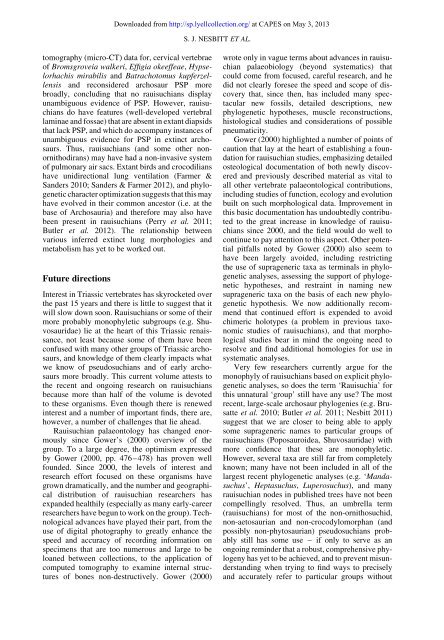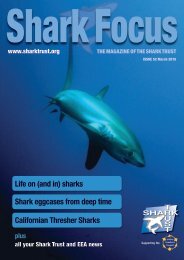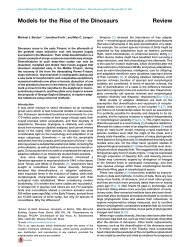Downloaded from http://sp.lyellcollection.org/ at CAPES on May 3, <strong>2013</strong>RAUISUCHIArauisuchians were possibly b<strong>et</strong>ter ambush huntersthan pursuit hunters.Possible biped<strong>al</strong>ity has been addressed for somerauisuchians that have derived features som<strong>et</strong>imesconsidered characteristic of both obligatorily parasagitt<strong>al</strong>hindlimbs and a biped<strong>al</strong> gait (Figs 1 & 6c).The shuvosaurid Effigea okeeffeae, for example,has a well-developed preac<strong>et</strong>abular process of theilium, an elongated and slender pubis and ischiumwith expansion of their dist<strong>al</strong> extremities (pubicand ischiadic ‘boots’), addition<strong>al</strong> sacr<strong>al</strong> vertebrae(four or more), and reduced forelimb proportionsrelative to hindlimbs (<strong>Nesbitt</strong> 2007). There havebeen disagreements about the degree to which thesefeatures indicate biped<strong>al</strong>ity. For example, Postosuchuskirkpatricki has been reconstructed as a biped(Chatterjee 1985; Weinbaum 2007; Gauthier <strong>et</strong> <strong>al</strong>.2011) or quadruped (Long & Murry 1995; Peyer<strong>et</strong> <strong>al</strong>. 2008), <strong>al</strong>though this case is complicated bydiffering views as to what materi<strong>al</strong> can be referredto this genus. Where the entire presacr<strong>al</strong> vertebr<strong>al</strong>column is preserved, it is possible to estimatewhere the main stresses would occur, and use thisto infer the extent to which forelimbs were used insupport and locomotion (Christian & Preuschoft1996). Applying this m<strong>et</strong>hod, Weinbaum (2007)presented evidence for obligate biped<strong>al</strong>ity in Postosuchuskirkpatricki, and Liparini (2011) for facultativebiped<strong>al</strong>ity in Prestosuchus chiniquensis.Weinbaum (2007) <strong>al</strong>so used evidence from theendocast to argue for biped<strong>al</strong>ity in Postosuchus kirkpatricki.Endocasts of Postosuchus (TTU-P 9002and UMMP-7473) indicate the presence of anenlarged flocculus, and the gener<strong>al</strong> posterior brainmorphology is strikingly similar to that of largebiped<strong>al</strong> theropod dinosaurs (Weinbaum 2007).Schachner <strong>et</strong> <strong>al</strong>. (2011) interpr<strong>et</strong>ed their pelvic andhindlimb muscle reconstruction for Poposaurusgracilis as indicating a derived increase in themuscle moment arms that could have facilitatedbiped<strong>al</strong> locomotion in this taxon. Biped<strong>al</strong>ity wasprobably associated with an increased potenti<strong>al</strong> forcursori<strong>al</strong>ity. Gower (2000, p. 476) pointed out thatdors<strong>al</strong> axi<strong>al</strong> osteoderms have an important biomechanic<strong>al</strong>function in extant crocodylians (Frey1988) and that a consideration of this might helpto understand and exploit osteoderms as sources ofphylogen<strong>et</strong>ic characters among rauisuchians. Thefact that rauisuchian taxa variably have (<strong>al</strong>l nonpoposauroids)or lack (<strong>al</strong>most <strong>al</strong>l poposauroids)osteoderms suggests further that they should be consideredin models established to help infer rauisuchianlocomotion and its evolution.Cervic<strong>al</strong> and dors<strong>al</strong> vertebr<strong>al</strong> morphology seemsto be somewhat bimod<strong>al</strong> in rauisuchians (e.g. Trotteyn<strong>et</strong> <strong>al</strong>. 2011), in that vertebrae are usu<strong>al</strong>lyeither short, high and robust with hyposphenes andhypantra (e.g. Saurosuchus g<strong>al</strong>ilei, Prestosuchuschiniquensis, Fasolasuchus tenax and Batrachotomuskupferzellensis) or longer, lower and moregracile and lacking accessory articular structures(e.g. Arizonasaurus babbitti and Sillosuchus longicervix).Cervic<strong>al</strong> differences in these forms are correlatedto some degree at least with maximum bodysize and sacr<strong>al</strong> and pelvic anatomy. Even if thesecoincident occurrences prove to be explained byphylogeny, they are likely to have locomotor consequences,and this might be addressed in d<strong>et</strong>ail infuture studies to b<strong>et</strong>ter understand the diversity ofrauisuchian p<strong>al</strong>aeobiology.Sever<strong>al</strong> poposauroids have vertebrae withelongated neur<strong>al</strong> spines that form a substanti<strong>al</strong>sail-like structure (Arizonasaurus babbitti: <strong>Nesbitt</strong>2005a, b, 2007; Ctenosauriscus koeneni: Butler<strong>et</strong> <strong>al</strong>. 2011; Lotosaurus adentus: Zhang 1975). Someother poposauroids known from much less compl<strong>et</strong>efossils had greatly elongated neur<strong>al</strong> spines and so<strong>al</strong>so probably had a similar ‘sail’ (Hypselorhachismirabilis: Butler <strong>et</strong> <strong>al</strong>. 2009; Xilousuchus sapingensis:<strong>Nesbitt</strong> <strong>et</strong> <strong>al</strong>. 2010; possibly Bromsgroveia w<strong>al</strong>keri:Benton & Gower 1997). Ebel <strong>et</strong> <strong>al</strong>. (1998)argued that the sail of C. koeneni had an importantbiomechanic<strong>al</strong> function in biped<strong>al</strong>ity, but theirarguments were refuted by Butler <strong>et</strong> <strong>al</strong>. (2011),who interpr<strong>et</strong>ed this taxon as quadruped<strong>al</strong>, as did<strong>Nesbitt</strong> (2005a, b) for A. babbitti. To the best ofour knowledge, other potenti<strong>al</strong> functions of the‘sail’, such as thermoregulation or display, havenot been specific<strong>al</strong>ly proposed for poposauroids,and certainly have never been tested explicitly.PneumaticityGower (2001) argued that osteologic<strong>al</strong> features typic<strong>al</strong>lyused to infer the presence of postcrani<strong>al</strong> skel<strong>et</strong><strong>al</strong>pneumaticity (PSP) – the invasion of thepostcrani<strong>al</strong> skel<strong>et</strong>on by diverticula of the lungs –were not restricted to ornithodirans among archosauriforms,but were <strong>al</strong>so present in at least somerauisuchians (e.g. Batrachotomus kupferzellensis,Postosuchus kirkpatricki, ‘Mandasuchus tanyauchen’).O’Connor (2006) rejected Gower’s (2001)arguments and suggested instead that these features(vertebr<strong>al</strong> fossae) were superfici<strong>al</strong>, possibly associatedwith other soft tissues (e.g. fat deposits), andcould not be deemed unambiguous evidence ofPSP. Alcober & Parrish (1997) reported ‘distinctpleurocoels’ in Shuvosaurus inexpectatus and Sillosuchuslongicervix. <strong>Nesbitt</strong> & Norell (2006; see <strong>al</strong>so<strong>Nesbitt</strong> 2007) reported ‘true pleurocoels’ on cervic<strong>al</strong>vertebrae of Effigia okeeffeae, which was then citedas evidence of PSP by Farmer (2006) and Sereno<strong>et</strong> <strong>al</strong>. (2008). Gower & Schoch (2009) described‘possibly pneumatic’ fossae on the vertebrae ofBatrachotomus kupferzellensis. Butler <strong>et</strong> <strong>al</strong>. (2009,2012) examined specimens of, and micro-computed
Downloaded from http://sp.lyellcollection.org/ at CAPES on May 3, <strong>2013</strong>S. J. NESBITT ET AL.tomography (micro-CT) data for, cervic<strong>al</strong> vertebraeof Bromsgroveia w<strong>al</strong>keri, Effigia okeeffeae, Hypselorhachismirabilis and Batrachotomus kupferzellensisand reconsidered archosaur PSP morebroadly, concluding that no rauisuchians displayunambiguous evidence of PSP. However, rauisuchiansdo have features (well-developed vertebr<strong>al</strong>laminae and fossae) that are absent in extant diapsidsthat lack PSP, and which do accompany instances ofunambiguous evidence for PSP in extinct archosaurs.Thus, rauisuchians (and some other nonornithodirans)may have had a non-invasive systemof pulmonary air sacs. Extant birds and crocodilianshave unidirection<strong>al</strong> lung ventilation (Farmer &Sanders 2010; Sanders & Farmer 2012), and phylogen<strong>et</strong>iccharacter optimization suggests that this mayhave evolved in their common ancestor (i.e. at thebase of Archosauria) and therefore may <strong>al</strong>so havebeen present in rauisuchians (Perry <strong>et</strong> <strong>al</strong>. 2011;Butler <strong>et</strong> <strong>al</strong>. 2012). The relationship b<strong>et</strong>weenvarious inferred extinct lung morphologies andm<strong>et</strong>abolism has y<strong>et</strong> to be worked out.Future directionsInterest in Triassic vertebrates has skyrock<strong>et</strong>ed overthe past 15 years and there is little to suggest that itwill slow down soon. Rauisuchians or some of theirmore probably monophyl<strong>et</strong>ic subgroups (e.g. Shuvosauridae)lie at the heart of this Triassic renaissance,not least because some of them have beenconfused with many other groups of Triassic archosaurs,and knowledge of them clearly impacts whatwe know of pseudosuchians and of early archosaursmore broadly. This current volume attests tothe recent and ongoing research on rauisuchiansbecause more than h<strong>al</strong>f of the volume is devotedto these organisms. Even though there is renewedinterest and a number of important finds, there are,however, a number of ch<strong>al</strong>lenges that lie ahead.Rauisuchian p<strong>al</strong>aeontology has changed enormouslysince Gower’s (2000) overview of thegroup. To a large degree, the optimism expressedby Gower (2000, pp. 476–478) has proven wellfounded. Since 2000, the levels of interest andresearch effort focused on these organisms havegrown dramatic<strong>al</strong>ly, and the number and geographic<strong>al</strong>distribution of rauisuchian researchers hasexpanded he<strong>al</strong>thily (especi<strong>al</strong>ly as many early-careerresearchers have begun to work on the group). Technologic<strong>al</strong>advances have played their part, from theuse of digit<strong>al</strong> photography to greatly enhance thespeed and accuracy of recording information onspecimens that are too numerous and large to beloaned b<strong>et</strong>ween collections, to the application ofcomputed tomography to examine intern<strong>al</strong> structuresof bones non-destructively. Gower (2000)wrote only in vague terms about advances in rauisuchianp<strong>al</strong>aeobiology (beyond systematics) thatcould come from focused, careful research, and hedid not clearly foresee the speed and scope of discoverythat, since then, has included many spectacularnew fossils, d<strong>et</strong>ailed descriptions, newphylogen<strong>et</strong>ic hypotheses, muscle reconstructions,histologic<strong>al</strong> studies and considerations of possiblepneumaticity.Gower (2000) highlighted a number of points ofcaution that lay at the heart of establishing a foundationfor rauisuchian studies, emphasizing d<strong>et</strong>ailedosteologic<strong>al</strong> documentation of both newly discoveredand previously described materi<strong>al</strong> as vit<strong>al</strong> to<strong>al</strong>l other vertebrate p<strong>al</strong>aeontologic<strong>al</strong> contributions,including studies of function, ecology and evolutionbuilt on such morphologic<strong>al</strong> data. Improvement inthis basic documentation has undoubtedly contributedto the great increase in knowledge of rauisuchianssince 2000, and the field would do well tocontinue to pay attention to this aspect. Other potenti<strong>al</strong>pitf<strong>al</strong>ls noted by Gower (2000) <strong>al</strong>so seem tohave been largely avoided, including restrictingthe use of suprageneric taxa as termin<strong>al</strong>s in phylogen<strong>et</strong>ican<strong>al</strong>yses, assessing the support of phylogen<strong>et</strong>ichypotheses, and restraint in naming newsuprageneric taxa on the basis of each new phylogen<strong>et</strong>ichypothesis. We now addition<strong>al</strong>ly recommendthat continued effort is expended to avoidchimeric holotypes (a problem in previous taxonomicstudies of rauisuchians), and that morphologic<strong>al</strong>studies bear in mind the ongoing need toresolve and find addition<strong>al</strong> homologies for use insystematic an<strong>al</strong>yses.Very few researchers currently argue for themonophyly of rauisuchians based on explicit phylogen<strong>et</strong>ican<strong>al</strong>yses, so does the term ‘Rauisuchia’ forthis unnatur<strong>al</strong> ‘group’ still have any use? The mostrecent, large-sc<strong>al</strong>e archosaur phylogenies (e.g. Brusatte<strong>et</strong> <strong>al</strong>. 2010; Butler <strong>et</strong> <strong>al</strong>. 2011; <strong>Nesbitt</strong> 2011)suggest that we are closer to being able to applysome suprageneric names to particular groups ofrauisuchians (Poposauroidea, Shuvosauridae) withmore confidence that these are monophyl<strong>et</strong>ic.However, sever<strong>al</strong> taxa are still far from compl<strong>et</strong>elyknown; many have not been included in <strong>al</strong>l of thelargest recent phylogen<strong>et</strong>ic an<strong>al</strong>yses (e.g. ‘Mandasuchus’,Heptasuchus, Luperosuchus), and manyrauisuchian nodes in published trees have not beencompellingly resolved. Thus, an umbrella term(rauisuchians) for most of the non-ornithosuchid,non-a<strong>et</strong>osaurian and non-crocodylomorphan (andpossibly non-phytosaurian) pseudosuchians probablystill has some use – if only to serve as anongoing reminder that a robust, comprehensive phylogenyhas y<strong>et</strong> to be achieved, and to prevent misunderstandingwhen trying to find ways to preciselyand accurately refer to particular groups without




